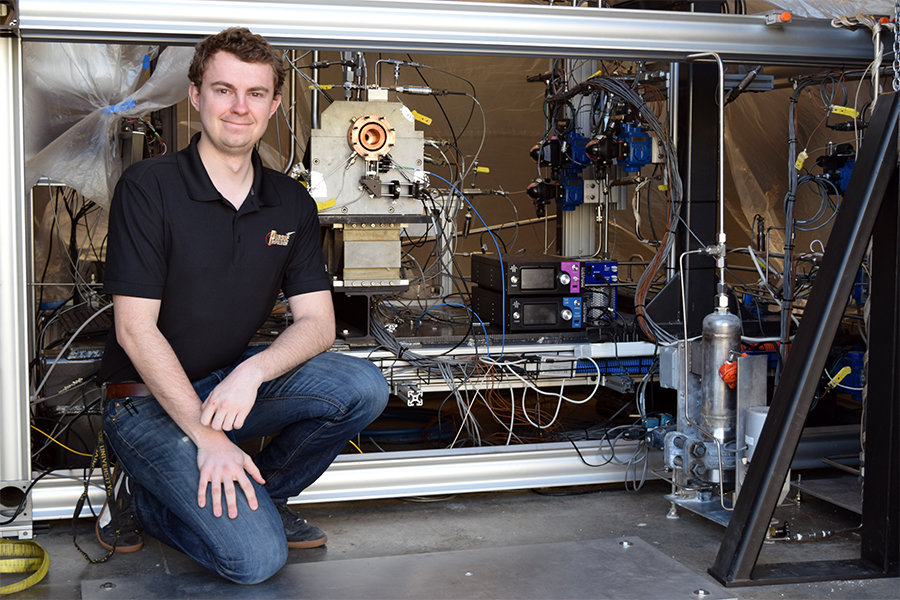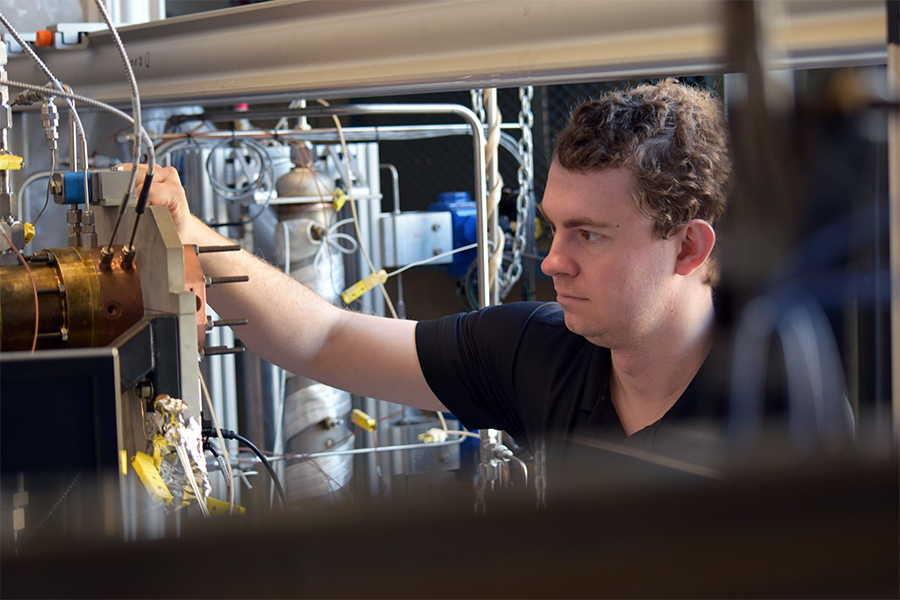The 20 Twenties: Ethan Plaehn

The return trip will be special.
Ethan Plaehn won’t just be casually strolling through the Smithsonian National Air and Space Museum in Washington D.C. this week with glancing views of the Lunar Module LM-2, the Wright Flyer, the Gemini IV or the “Spirit of St. Louis.” He likely will pause in front of each, appreciating the craftsmanship of the time, savoring the accomplishments despite the technology, mind churning about how many advancements there have been since, in structures, in components, in engine capacity.
Surely, he will be reminded of a seed planted, an idea sparked during his first trip as a junior in high school — and allow for reflection on the steps taken since, choices that have led here, to eyes seeing with new perspective.
As a graduate student in the School of Aeronautics and Astronautics studying propulsion, Plaehn will have better understanding on this trip.
“Seeing it all, the history of it, in one place and how you evolve from the old propeller from the Wright brothers to the Moon lander and how it all came together, it was pretty impressive,” said Plaehn, thinking back on his first impressions of the museum. “I was just thinking, ‘I could be part of this history.’ It’ll be pretty neat to go back and see it all again and be like, ‘Now, I’m really in it and working toward it.’ ”
The evidence of that growth: Plaehn’s museum visit actually is only a side trip.
He’s in D.C. to be recognized as one of “Tomorrow’s Technology Leaders: The 20 Twenties” by Aviation Week Network, in collaboration with the American Institute of Aeronautics and Astronautics. Plaehn and the other winners — which also include another AAE graduate student, Emily Beckman — will be celebrated at an awards luncheon March 12 and also will attend Aviation Week’s 63rd Annual Laureate Awards, a black-tie event that honors luminaries from the industry who have designed, engineered and innovated at the highest levels.
Plaehn, who rented a tuxedo for the upscale gala that he will attend with girlfriend and Purdue alumna Erin Carlstrom, said he is looking forward to networking with the accomplished professionals and especially with the other 20 Twenties.
Likely at some point during the day, Plaehn will reflect on the moment he learned of his selection.
“It was actually cool because it on my birthday in December that I learned that I got it,” he said. “I am honored to be selected. I know many students apply to receive this award, and many students that are not selected are still deserving of the award through their own studies and research projects. I am thankful to all of the professors, research engineers and my fellow lab mates who have helped me at Zucrow Labs and have put me in the position to be able to be nominated for this award.”
Since that initial announcement, Plaehn — fittingly pronounced “plane” — has been putting in effort and hours at Maurice J. Zucrow Laboratories to develop his research experiment.
Zucrow is a second home now, really, and that’s exactly how Plaehn likes it.

He initially was introduced to the labs as an undergrad — the Colorado native chose Purdue over the University of Colorado Boulder out of high school — when he got a tour from a then-research engineer. Even that was a sign of Plaehn’s career destiny.
When Plaehn’s mother, Purdue alumna Marla, saw a fraternity newsletter to Plaehn’s father, Purdue alumnus Bill, she recognized the person featured in an alumni spotlight. Andrew Pratt was a friend through church in Fort Wayne, and Marla suggested Ethan reach out to see if he could check out Zucrow.
Ethan Plaehn did just that. And during his sophomore year, Plaehn found himself helping install experiments in the High Pressure Combustion Laboratory (ZL8) test cells, part of a Zucrow expansion in 2017.
By the time Plaehn was a senior, he knew propulsion was the track he wanted to take, and he launched a model rocket as a senior as part of a class. Most of the work for that was done at Zucrow, the premier university propulsion test facility in the world.
Partly because of that experience, Plaehn opted to stay at Purdue for graduate school.
“Every school has the thing they’re good at, and Purdue is really good at experimental propulsion. There’s not any lab that has this magnitude of scale of what they do. That’s what I wanted to research, so it kind of worked out,” Plaehn said.
Plaehn connected with Carson Slabaugh, an assistant professor in AAE, and found an exciting opportunity for research. The first-year master’s student who was awarded a National Science Foundation Graduate Research Fellowship in 2019 is studying rotating detonation engines (RDEs). RDEs are a potentially powerful propulsion method with the capability to improve the performance of air-breathing and rocket engines. As of now, no aircraft or rocket uses a rotating detonation engine.
RDEs use detonations to achieve a pressure gain combustion. That allows for additional work to be generated with the same chemical energy input, resulting in higher engine efficiency.
Plaehn is excited about the research because “it’s pretty experimental and new, and there’s a lot of room to grow.”
“It’s a really big thing to try and solve, so you have to come at it from a lot of different angles,” Plaehn said. “You’re not boxed in. You’re not going to focus on this small spot — (if) most of it already had been developed. It’s a pretty open-ended question. So there is a lot to do, and there are a lot of ideas from Professor Slabaugh and a lot that I can come up with on my own. Certain aspects of the experimental design that Professor Slabaugh pitched to me sounded cool. I like hypersonic aircraft and missile systems and stuff, so RDEs are a good option for use on airplanes like that. It kind of opens up the gate for that.”
Plaehn specifically will research how different engine component geometries and propellant mixtures can affect the performance and operability of a RDE. He’ll try different injectors, nozzles and annular gaps to see how they’re each affecting performance.
Currently, Plaehn is working on the design and build-up of his experiment. Even that is enjoyable, he said, because he likes hands-on work. He knows he’ll enjoy the testing, too, and he’ll need to learn how to analyze data and write papers.
“At certain jobs in industry, you might be targeted on one specific aspect of a project, but out here you can do from design, to build, to test, to analyzing, to writing. It’s fun to be part of all of that,” Plaehn said.
While he’s designing his own experiment, Plaehn is helping another research student, Aaron Lemcherfi, with his research. Even in the latter work — Plaehn helped install and plumb the engine, collected data and tested it — he’s seeing how rewarding his own work could eventually be.
During a recent presentation from Lemcherfi’s research, Lemcherfi shared how he’d found a specific detonation wave structure and repeated over multiple tests. Satisfaction often comes in those small victories.
“It’s cool to see that aspect and be like, ‘That’ll be me in a few years,’ finding little things that can add to the overall solution,” Plaehn said.

